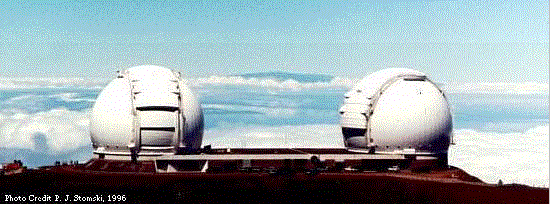Astronomy Picture of the Day
Discover the cosmos!
Each day a different image or photograph of our fascinating universe is
featured, along with a brief explanation written by a professional
astronomer.
July 15, 1996

Keck: The Largest Optical Telescope
Credit:
P. Stomski
(W. M. Keck
Observatory),
Caltech,
U. California
Explanation:
In buildings eight stories tall rest mirrors ten meters across that are
slowly allowing humanity to map the universe. Alone, each is the
world's
largest optical telescope:
Keck.
Together, the twin Keck telescopes have the
resolving power of a single telescope 90-meter in diameter, able to discern
sources just milliarcseconds
apart. Since
opening in 1992, the real power of Keck I (left) has been in its
enormous
light-gathering ability - allowing
astronomers to
study faint and
distant objects in
our Galaxy and
the universe.
Keck II,
completed earlier this year, and its twin are located on the dormant volcano
Mauna
Kea,
Hawaii,
USA. In the distance is Maui's volcano Haleakala. One reason Keck was built was because of the
difficultly for astronomers to get funding for a smaller telescope.
Tomorrow's picture: A Portrait of Saturn from Titan
| Archive
| Index
| Search
| Glossary
| Education
| About APOD |




Authors & editors:
Robert Nemiroff
(MTU) &
Jerry
Bonnell (USRA).
NASA Technical Rep.:
Sherri
Calvo.
Specific rights apply.
A service of:
LHEA
at
NASA/
GSFC




